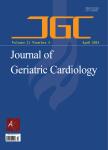Low density lipoprotein cholesterol level inversely correlated with coronary flow velocity reserve in patients with Type 2 diabetes
Low density lipoprotein cholesterol level inversely correlated with coronary flow velocity reserve in patients with Type 2 diabetes作者机构:Department of Cardiology Peking University Third Hospital Key Laboratory of Molecular Cardiovascular Sciences Ministry of Education Beijing 100191 China Department of Endocrinology Beijing Chaoyang Hospital Affiliated to Capital Medical University Beijing 100020 China
出 版 物:《Journal of Geriatric Cardiology》 (老年心脏病学杂志(英文版))
年 卷 期:2013年第10卷第2期
页 面:159-164页
核心收录:
主 题:Coronary flow velocity reserve Diabetes mellitus Endothelial function High-density lipoprotein cholesterol Low-density lipoprotein cholesterol
摘 要:Objectives To evaluate the association of coronary artery endothelial function and plasma levels of low density lipoprotein cholesterol (LDL-C) and high density lipoprotein cholesterol (HDL-C) in patients with Type 2 Diabetes Mellitus (DM). Methods We investigated 90 participants from our institution between October 2007 to March 2010: non-DM(n = 60) and DM(n = 30). As an indicator of coronary endothelial dysfunction, we used non-invasive Doppler echocardiography to quantify coronary flow velocity reserve (CFVR) in the distal part of the left descending artery after rest and after intravenous adenosine administration. Results Plasma level of LDL-C was significantly higher in patients with DM than in non-DM (3.21 ±0.64 vs. 2.86 ±0.72 mmo/L, P 0.05), but HDL-C level did not differ between the groups (1.01 ±0.17 vs. 1.05 ±0.19 mmo/L). Furthermore, the CFVR value was lower inDMpatients than non-diabetics (2.45 ±0.62 vs. 2.98 ±0.68, P 0.001). Plasma levels of LDL-C were negatively correlated with CFVR in all subjects (r = ��0.35, P 0.001; 95% confidence interval (CI): ��0.52 –��0.15) and in the non-DM(r = ��0.29, P 0.05; 95% CI: ��0.51–��0.05), with an even stronger negative correlation in the DM group (r = ��0.42, P 0.05; 95%CI: ��0.68 –��0.06). Age (β= ��0.019, s = 0.007, sβ= ��0.435, 95% CI: ��0.033 –��0.005, P = 0.008), LDL-C (β= ��0.217, s = 0.105, sβ= ��0.282, 95% CI: ��0.428 –��0.005, P = 0.045) remained independently correlated with CFVR in the DM group. However, we found no correlation between HDL-C level and CFVR in any group. Conclusions Diabetes may contribute to coronary artery disease (CAD) by inducing dysfunction of the coronary artery endothelium. Increased LDL-C level may adversely impair coronary endothelial function in DM. HDL-C may lose its endothelial-protective effects, in part as a result of pathological conditions, especially under abnormal glucose metabolism.



